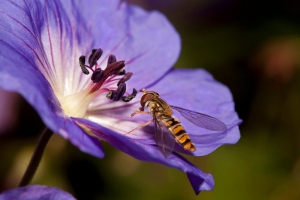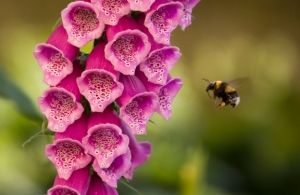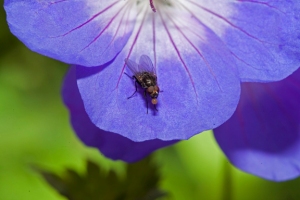Life on Rozanne
September 19, 2011 § 25 Comments
One of the best hardy geraniums is ‘Rozanne’. It has large purple flowers that bloom from early summer until autumn. In a good year, it performs for six months. It is a tremendous sprawler, and isn’t recommended for small gardens. Even though we don’t really have the room, we grow it in several of our borders. We control its conquistadorial tendencies by hacking chunks off the clumps — which is really a form of extreme dead-heading. It looks frightened for a few days, and then it quickly pulls itself together and produces a fresh flush of flowers.
For years, ‘Rozanne’ was confused with the very similar ‘Jolly Bee’, and only gardeners-in-the-know professed to be able to tell the difference. One was more sprawly than the other. Or maybe not. [Warning: unless you have a burning desire to watch a nomenclatural tangle being unravelled, you might want to skip the next paragraph. But, do click on all the photos in this post: they’re quite interesting. I’ve a novel surprise for you at the end, as well.]
Both are hybrids of G. wallichianum ‘Buxton’s Variety’, with G. himalayense providing the other parent for the first, and G. shikokianum var. yoshiianum for the second. And both are patented plant varieties, which means that they have brought in wads of revenue for the patent holders — Blooms of Bressingham and Dutch breeder Marco Van Noort, respectively. However, in 2010, a court ruled that they were too similar to be distinguishable, and that ‘Jolly Bee’ should cease to exist as a separate variety — bad news for Van Noort, who would no longer receive plant breeder’s royalties. To confuse matters further — and such are the convolutions of plant nomenclature — the original name of ‘Rozanne’ is ‘Gerwat’ (the first appellation under which it was registered) although it is known as Rozanne® in the trade.
The thing that is rarely written about ‘Rozanne’ though (or ‘Jolly Bee’, for that matter), is that it is a complete hit with invertebrates. Honeybees, bumblebees, flies, hoverflies, ants and other small creatures flock to it, to drink its nectar and to pluck the bits of pollen that are tucked into its stamens.
The marmalade fly (above) is one of the few hoverflies that actually eats pollen. Before ingesting the grains, it crushes them between its front legs (I nearly said “paws”, as I have a huge affection for this particular species and find it easy to get a little woolly about it).
‘Rozanne’ is sterile, that is, it produces no seed. This characteristic allows it to bloom for a very long period. Normally, a plant’s biological clock tells it to stop flowering when it has made enough seed to perpetuate itself, but a sterile plant has no “stop” for the blooming mechanism. It flowers until colder weather and lower light levels say it’s time — finally — to quit. So, the gooey amber pollen grains that you see stuck to the furry stigma below have fallen on barren ground, as it were.
I’ve noticed more insect varieties on ‘Rozanne’ than I have on any other plant in my garden. Here is a pretty common carder bumblebee (Bombus pascuorum):
In my patch (and in many other Irish gardens) it is the most frequent bumblebee visitor. One of its identifying features is its furry, ginger-coloured waistcoat. In sunny weather, the hairs can become bleached, turning it into a blonde bumbo. If you look closely while it is feeding, you’ll see that it has quite a long tongue. It is one of only two bee species that feeds on our native foxglove. The other is the garden bumblebee (Bombus hortorum), which has the longest tongue of any bee in the UK and Ireland: 1.5 to 2 centimetres when at full stretch. It often leaves it extended when it is flying between foxglove blooms, as below:
But back to ‘Rozanne’. It is also, as I mentioned earlier, very popular with flies. I’ve seen loads of different species visiting. I’m not sure of this one’s name (if there are any dipterists reading this, please do help), but it didn’t mind standing quietly and having its picture taken:
Let’s take a closer look at that:
Yes, the fly is blowing a bubble. Slowly, slowly out and slowly, slowly in. I’m not sure why it does this, but I have read that it may aid food digestion. In any case, it was so focussed on bubble-blowing that it stayed perfectly still while it was having its portrait taken. Isn’t it lovely?








What a great blog Jane, so informative, thank you! And stunning pictures, the final fly one is amazing 🙂
LikeLike
A fly blowing bubbles while having its picture taken – I’d suggest it was a teenager, except that they generally hide from the camera with a skill that must be courtesy of all those raging hormones. Great photos.
LikeLike
I must immediately run out and look at the insects – alas we have hardly seen a honey bee in the garden this year but I’ve certainly noticed how the hoverflies love Rozanne. And I also love the way it thrives equally in gravel, heavy clay and soggy peat. It has been one of my great discoveries of the last couple of years. And as you said, it barely misses a beat when you hack it right back to allow its neighbours to breathe – I like the concept of an extreme form of dead heading. It does make it possible to use it in confined spaces though. And thus it is even a generous contributor to the compost pile 🙂
LikeLike
What an amazing shot of the fly! Who knew they blew bubbles.
Sadly after an amazing start to the season in April – we have had very few bees in the garden until this month, although hoverflies a-plenty.
Rozanne is indeed a delightful thug.
K
LikeLike
Blow – I used amazing twice, must expand my vocabulary!
😦
K
LikeLike
Ewwwwwwwww! I do not like that bubble-blowing fly! Fantastic bumblebee knowledge Jane. Please come to my garden next summer and ID my geraniums. Their flowers are all different shades of purple but some have furry leaves and some don’t. One is still flowering – I presume this is ‘Rozanne’.
xx
LikeLike
Thanks, Elizabeth, Janet and Karen — the bubble blowing was a revelation for me too. I’ve been looking at the little pictures in the garden for the last several years, and I am seeing all kinds of exciting things.
Kathryn – I agree, ‘Rozanne’ is a great “doer”. Our soil is really dry, but it thrives. It doesn’t much like shade though, as I discovered. But there are are loads of other good shade-tolerant geraniums, as you know.
Kate — how can you NOT like the bubble blowing?
LikeLike
Because it’s gross, that’s why!
LikeLike
Jane,
The photographs are exceptionally good; you are obviously playing with a great macro lens and using it expertly.
Re G. ‘Rozanne’, I find it the most useful plant to place among large drifts of spring bulbs. It takes up very little space at the root, doesn’t seem to spread at the root either and then covers up all that bare earth left when the bulb foliage has died down. It is particularly good among bulbs which one considers precious as you don’t have to plant on top of the bulbs at all and so there is no risk of damaging them.
Great blog, loved it.
Paddy
LikeLike
Jane , thanks for sharing the information with us . I must try to get Rozanne somewhere as apart from attracting insects it is a lovely colour !
LikeLike
Heavenly photographs! Love the bubble blower. It’s a facinating read too and is making me think I could do with more detailed knowledge especially of bees, which are wonderful and I follow them around so much….thanks Jane, more please:~)
LikeLike
That was beautiful! I loved the photos-you must have come by them with acute observation, patience, and intense dedication. Thank you 🙂
LikeLike
Rozanne is one of my best hardy Geraniums of my collection in our small garden,I would not like to be without it, what a beautiful colour for most of the garden season. the best plant around :~)
LikeLike
This is now my very favourite fly picture. What camera did you use? Beautiful detail and stunning colour.
Sheila Averbuch– Stopwatch Gardener
LikeLike
I’ve loved Rozanne geraniums since they came out and have wonderful what happened to Jolly Bee – it’s slightly bluer cousin. Great info and pictures. Do you know what ever happened to Tiny Monster geranium – they seem hard to find now also.
LikeLike
Hi Barbara, I see you are in the USA, so I’m not sure about ‘Tiny Monster’ over there. It’s available in Ireland and the UK in some places, but maybe it didn’t suit American conditions? I’ve never grown it, but have admired it.
LikeLike
Thanks for all the very nice comments!
Paddy — Yes, ‘Rozanne’ is a great post-bulb performer. I use it over my snowdrop bed, among other places.
Sheila — It’s quite an old camera at this point (4 or 5 years old?): a Canon 5D, with a 100mm/F2.8 macro. My husband has newer and higher-resolutioned cameras, which I think I might switch to for this kind of thing. I crave MORE detail! It’s important always to shoot RAWs, of course.
LikeLike
A bee-keeping friend left a message with the following info, which is interesting:
Bees blow ‘bubbles’ of nectar to evaporate water off to, eventually, make it thick enough to be honey (if moisture content too high it will ferment). Maybe the fly was concentrating the ‘fluid’ – the nature of which I fear to consider – as, as you say, an aid to digestion, weird. Alternatively he enjoyed it so much the first time he just had to try it again!
LikeLike
You may yet help me appreciate flies. Well-done!
LikeLike
Well, I only really started appreciating them when I started taking photos and blowing them up. Some of them are quite beautiful!
LikeLike
Jane, great to see such wonderful photos of the little visitors to our gardens. Must show this to my four year old…he loves spotting bugs in the garden.
LikeLike
Oh, do show them to your young fellow! He may grow up to be a dipterist and then he can ID my flies 🙂
LikeLike
Jane, eventually, my two brain cells have met and the name of another similarly good geranium has returned to me. G. ‘Ann Thompson’ is of similar habit with large magenta flowers and is an excellent plant in the garden and, again, particularly good planted to cover spring bulbs.
Paddy
LikeLike
And ‘Patricia’ is another one! And possibly ‘Brookside’ — I’ve never grown it, so don’t know how it behaves. (I would love to hear from Brookside-growers!) But I think that ‘Rozanne’ may have the edge on attracting critters, perhaps because of its colour? And maybe the white centres are tempting too?
LikeLike
[…] last year was Erysimum ‘Bowles’s Mauve’. Although it didn’t win (the prize went instead to Geranium ‘Rozanne’), I was delighted to see the perennial wallflower on the list, as it has nearly dropped out of […]
LikeLike